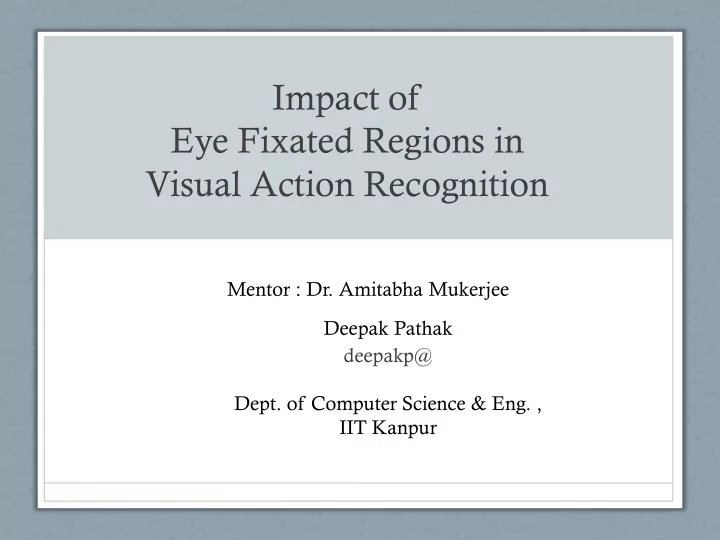

Impact of Eye Fixated Regions in Visual Action Recognition Mentor : Dr. Amitabha Mukerjee Deepak Pathak deepakp@ Dept. of Computer Science & Eng. , IIT Kanpur
Introduction • Human Action Recognition ( What ?) 150,000 uploads every day ! • Human actions are major event in movies , news etc. Why is it useful ? • • Annotating the videos • Content Based Browsing [UCF Sports Action Dataset] • Video Surveillance • Patient Monitoring • Analyzing sports videos • .. [Live Snapshot – earthcam.com]
Motivation • Issues in human action recognition – • Diversity - in actions (sitting , running , jumping etc) - interaction (hugging , shaking hands, fighting , killing etc) • Occlusions , noise, reflection, shadow etc • Computer vision techniques still lag significantly behind human performance on similar tasks. • Aim : • Study human gaze patterns in videos and utilize them • In activity recognition task. • Human visual saliency prediction
Human and Computer Vision [Poggio 2007] • Feature descriptor inspired from human visual cortex. Suggested hierarchical model with simplex features which are in coherence with the ventral stream of visual cortex. [Mathe 2012] • Provided large human eye tracking dataset recorded in context of dynamic visual action recognition tasks. • Proposed saliency detector and visual action recognition pipeline
Experiment • Recorded Human fixation for Hollywood-2 and UCF Sports Action Dataset • 16 Subjects (Both M/F) : Free viewing – 4 subjects : Action Recognition – 12 subjects 92 subject-video hours, 500Hz • sample rate. • Dataset – coordinates of fixation and saccadic movement of eyes. Experimental Setup [Mathe 2012]
Hollywood-2 Dataset * Realistic human actions in unconstrained video clips of hollywood movies. * 12 Action Classes * 823 Training Video clips 884 Test Video clips
Our Approach Eye “fixation” Get HoG3D descriptor points as Interest centered at these interest Points points K-means clustering to map it to Visual Vocabulary Train Classifier over the feature Done !! histograms Histogram of Visual words
Target Through this, we would like to explore: How useful is the foveated area formed by eye-fixated regions of entire video in the task of action classification ? o Will be determined by comparing the result of our approach with other state of the art performances.
Implementation Details (Our approach) • Interest points – Eye gaze („F‟ -fixation) coordinates of one subject with 12 frame overlap. (computational reasons) • Hog3D [Klaser 2008] descriptor for (823+884) videos. K-means clustering : • - mapping of 6 lac descriptors to 4000 word vocabulary (dimension=300) - each video : normalized histogram of 4000 bins Learn SVM (Support Vector Machines) over 823 training • videos feature histogram. Test over 884 test videos.
Intermediate Results Frame showing Interest point (From Eye Gaze data) Action – GetOutCar Action – FightPerson
Video Sample Embedded
Further Work • Can we extend this approach to design Human Visual Saliency Predictor ? • Yes ! By training binary classifier over feature descriptor. Input: HoG3D feature detector around each pixel of the video data. Output: Yes or No (being salient) • Problem – Might be computationally intensive.
References • Mathe, Stefan, and Cristian Sminchisescu. "Dynamic eye movement datasets and learnt saliency models for visual action recognition." Computer Vision-ECCV 2012. Springer Berlin Heidelberg, 2012. 842- 856. Mathe, Stefan, and Cristian Sminchisescu. Actions in the eye: • dynamic gaze datasets and learnt saliency models for visual recognition. Technical report, Institute of Mathematics of the Romanian Academy and University of Bonn (February 2012), 2012. • Klaser, Alexander, and Marcin Marszalek. "A spatio-temporal descriptor based on 3D-gradients." (2008). • Laptev, Ivan. "On space-time interest points." International Journal of Computer Vision 64.2 (2005): 107-123. – Hollywood-2 Dataset
HoG3D – Feature Descriptor This involves Gradient computation and Orientation binning. Gradient computation requires filtering the image with the kernels [-1,0,1] and [-1,0,1 ]‟ [CVPR „08] [Klaser 2008]
Recommend
More recommend